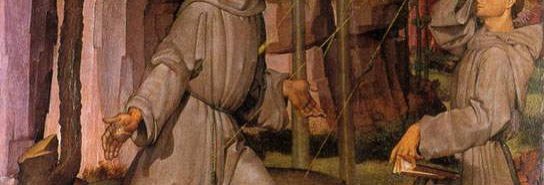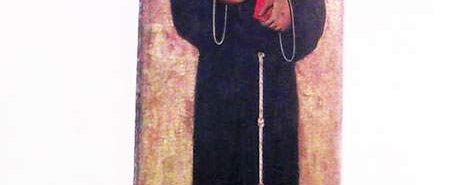A few days ago, our friends at A world to travel, published on their blog a post entitled 45 photos that will make you want to visit Castiglion Fiorentino (“45 photos that will make you want to visit Castiglion Fiorentino”). There’s no denying it: Inma and Jose as photographers are really great! And since we are not yet at their level, but we want to give you more reasons to visit Castiglion Fiorentino, we can’t help but talk about the subject we are most knowledgeable about:art! Yes, because Castiglion Fiorentino, besides history, nature, hospitality and great food, is also a lot of art, and there are really many artistic testimonies of the past that you can find there. There are so many that to talk about all of them in one post would be an arduous task: for this reason, today we have chosen six works of art that we think you cannot miss when you go to visit this beautiful village in the Valdichiana in Tuscany. Let’s get started right away!
1. The Stigmata of Saint Francis by Bartolomeo della Gatta

Bartolomeo della G atta is one of the most interesting painters to be found in Castiglion Fiorentino, as well as an excellent protagonist of the Tuscan Renaissance. This painting of his, which dates from 1486, was made for a confraternity in the town, the Confraternity of Mercy, and was to be made for the church of San Francesco: hence the reason for the choice of theme. A cherub, recognizable because it has the appearance of a head with red wings, carries in flight the crucifix that gives the stigmata to St. Francis. The style, vigorous and realistic, recalls that of Luca Signorelli, and the landscape is probably that of the hills around Castiglion Fiorentino. The detail of the barn owl leaning against the tree branch on the left is remarkable.... ! The work is in the Pinacoteca Comunale.
2. Saint Francis by Margarito d’Arezzo

With this painting we go back to the mid-13th century: Margarito d’Arezzo, an artist also mentioned by Giorgio Vasari in his Lives, is one of the most representative painters of the 13th century in the Arezzo area (he was a contemporary of Cimabue and Giotto). Vasari tells us that Margarito (or Margaritone) was “held to be excellent” “among the other painters of those times who worked in the Greek style,” that is, making an art that was inspired by Byzantine art, thus a very solemn and hieratic art. And this Saint Francis of his is precisely devoted to simplicity and solemnity: the saint is simply standing, holding a crucifix and gospel, dressed in his typical habit. Works of this kind were very common in medieval Tuscany. This painting also comes from the church of San Francesco and is in the Pinacoteca Comunale.
3. Reliquary bust of Saint Ursula

We do not know who is the author of this very fine bust-reliquary, that is, a bust in the shape of a saint (in our case St. Ursula), which was meant to contain her relics. All we know is that it is of French manufacture and that it can be dated to the fourth or fifth decade of the 14th century (so we are between 1330 and 1340). It is an exceptional work of goldsmithing, in embossed and chiseled silver and then gilded and painted, with inserts of precious stones, enamels and pearls. The face of the saint, which is painted in tempera, has a fixed gaze, and is elegantly framed by blond hair, obtained by gilding. The robe is chiseled (that is, it is worked with the chisel, a small chisel that was used to engrave metals and stones in order to create decorations) and in the center, on the chest, has a lapis lazuli stone. Further down, we notice a series of enamels decorating the robe and depicting figures of saints and some scenes from the life of St. Ursula. The whole is supported by four small Gothic dragons, which are very reminiscent of the typical French Gothic gargoyles, that is, the dragons and monsters that decorated the part of the eaves canals of churches and buildings from which water came out. The reliquary bust is located, also, in the Municipal Art Gallery.
4. Lamentation over the Dead Christ by Luca Signorelli

We do not know for sure when the great Luca Signorelli, to whom we also dedicated an episode of our podcast, created this fresco: perhaps between 1480 and 1490, but there are also those who prefer a later date, around 1505. What is certain is that to create the work, the artist enlisted the help of his workshop. And certain it is (and here it is enough to see the work!) that it is a very powerful and engaging painting, as is typical of almost all the works of the great artist from Cortona. This mourning, somewhat fragmentary but nevertheless still clearly legible, is very reminiscent of the more famous Lamentation over the Dead Christ that is in the Museo Diocesano in Cortona and which, being a work from 1502, would make a later date than the one in Castiglion Fiorentino seem plausible. Signorelli’s fresco is in the Museum of the Pieve di San Giuliano, an ancient church now converted, precisely, into a museum.
5. Risen Christ by Francesco Vanni

The work is by Francesco Vanni, who was the principal of those artists who worked in Siena at the turn of the sixteenth and seventeenth centuries and who, drawing on the painting of Federico Barocci, created a very active school. And, by the way, we also dedicated an episode of our podcast to Francesco Vanni! Christ rises above all the other figures, delicate and majestic at the same time, to the amazement of onlookers who are painted in very bright colors, typical of Mannerism. The scene is somber, but it is Christ himself who seems to brighten the environment! The painting is located in the magnificent Church of Jesus: impossible not to visit it!
6. Annunciation by Baccio Bonetti da Cortona

The artist was a painter of secondary importance who worked in the late sixteenth and early seventeenth centuries, and he used to copy works by more established artists: this is one of those cases, because this Annunciation is a copy of the more famous Annunciation by Jacopo Chimenti known as l’Empoli that is in the church of Santa Trinita in Florence. It is, however, an interesting painting, firstly because it is signed and dated (to be exact, 1626), and secondly because it is an example of a work intended for private devotion still preserved in the environment for which it was intended, and cases like this are not that frequent... ! The painting is located in the Sensi Chapel, named after the religious man who had it built, Pasquino Sensi: there is an inscription in the chapel attesting to its consecration in 1625.
Warning: the translation into English of the original Italian article was created using automatic tools. We undertake to review all articles, but we do not guarantee the total absence of inaccuracies in the translation due to the program. You can find the original by clicking on the ITA button. If you find any mistake,please contact us.